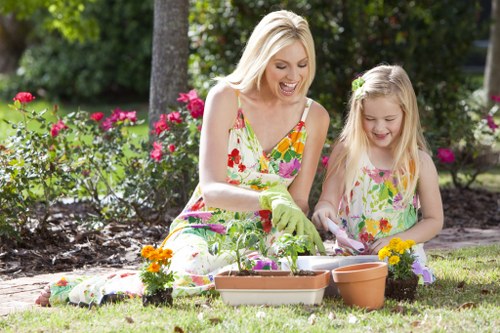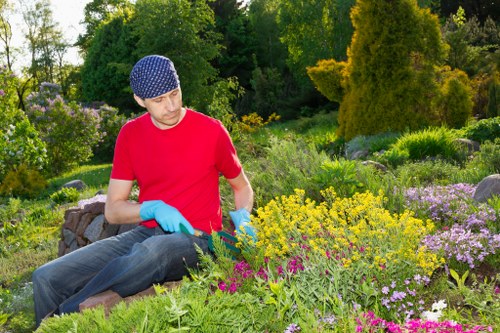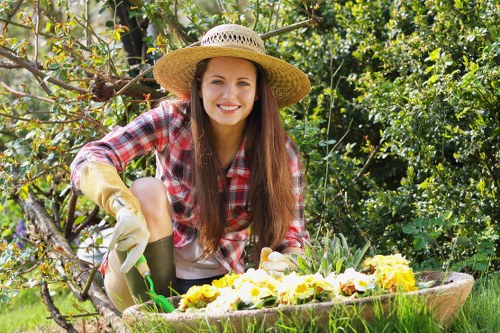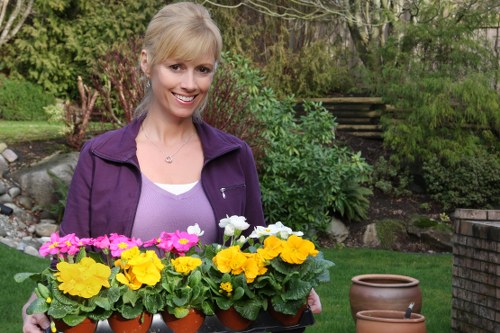Garden Maintenance in Bethnal Green: Keeping Your Garden Pristine All Year Round

Introduction to Garden Maintenance
Maintaining a beautiful garden in Bethnal Green requires dedicated care and regular upkeep. The unique climate and urban setting present both challenges and opportunities for gardening enthusiasts.
From planting seasonal blooms to ensuring the health of your lawns, effective garden maintenance involves a variety of tasks that contribute to the overall aesthetic and functionality of your outdoor space.
In this comprehensive guide, we will explore the essential aspects of garden maintenance in Bethnal Green, providing you with the knowledge and tips needed to keep your garden thriving throughout the year.

Seasonal Garden Care
Spring Maintenance
Spring is an ideal time to rejuvenate your garden. Start by cleaning up debris and preparing the soil for new growth. Planting spring bulbs and perennials can add vibrant colors to your garden beds.
Pruning shrubs and trees ensures healthy growth and enhances the shape of your plants. Additionally, consider installing a drip irrigation system to provide consistent moisture during the growing season.
Mulching helps retain soil moisture and suppress weeds, reducing the need for frequent watering and weeding. Choose organic mulch options to enrich the soil naturally.
Summer Maintenance
During the summer months, consistent watering is crucial to prevent plants from wilting. Implementing an efficient irrigation system can save time and resources while keeping your garden lush.
Regularly deadhead flowers to encourage continuous blooming and remove any diseased or damaged foliage to maintain plant health. It's also a good time to fertilize your garden to support growth.
Keep an eye out for pests and diseases, addressing issues promptly to avoid spread. Natural pest control methods can be effective and environmentally friendly.
Autumn Maintenance
As the weather begins to cool, focus on preparing your garden for the winter months. Remove annual plants that have completed their life cycle and compost them to enrich your soil.
Raking leaves not only keeps your garden tidy but also provides valuable organic material for composting. Planting autumn-flowering plants can extend the blooming season and add fall colors to your garden.
Protect tender plants by applying mulch or covering them with frost cloth to shield against early frosts. It's also the time to prune any remaining perennials and clean up garden tools.
Winter Preparation
Before winter sets in, ensure that all garden beds are well-mulched to protect roots from freezing temperatures. Store garden equipment in a dry place to prevent rust and damage.
Consider installing windbreaks or trellises to support plants during the harsh winter winds. Planning for next year's garden by brainstorming new plant ideas and redesigning layouts can save time later.
Finally, inspect your irrigation systems and repair any damage to ensure they're ready for spring. Proper winter maintenance sets the foundation for a successful gardening season.

Essential Tools for Garden Maintenance
Basic Gardening Tools
Having the right tools is essential for efficient garden maintenance. Basic tools include:
- Pruning shears
- Garden gloves
- Spade and shovel
- Rakes
- Watering cans or hoses
Investing in high-quality tools can make gardening tasks easier and more enjoyable, reducing the risk of injury and increasing productivity.
Additionally, consider ergonomic designs to minimize strain during prolonged use. Regularly maintaining your tools by cleaning and sharpening them prolongs their lifespan.
Advanced Equipment
For larger gardens or more intensive maintenance, advanced equipment such as lawnmowers, hedge trimmers, and tillers can be beneficial. These tools save time and provide a more polished look to your garden.
Battery-powered or electric tools are eco-friendly alternatives to traditional gas-powered equipment. They offer quieter operation and require less maintenance.
Store your equipment properly to protect them from the elements and ensure they're ready for use when needed.
Maintenance and Storage
Proper maintenance of your gardening tools is crucial for their longevity and performance. After each use, clean your tools to remove dirt and debris that can cause rust or deterioration.
Sharpening blades and oiling metal parts prevent rust and ensure your tools remain effective. For storage, keep tools in a dry, sheltered area to protect them from moisture and extreme temperatures.
Organizing your tools in a shed or garage with designated spaces can make your gardening tasks more efficient and enjoyable.

Soil Health and Fertility
Understanding Soil Types
The foundation of a healthy garden lies in the quality of your soil. Understanding the different types of soil present in Bethnal Green can help you make informed decisions about plant selection and maintenance practices.
Sandy Soil drains quickly but may lack essential nutrients. To improve its fertility, incorporate organic matter such as compost or well-rotted manure.
Clay Soil retains nutrients and moisture but can become compacted, making it difficult for roots to penetrate. Adding organic materials and using raised beds can enhance soil structure.
Improving Soil Quality
Regularly testing your soil's pH and nutrient levels provides valuable insights into its health. Based on the results, you can amend the soil to create optimal growing conditions for your plants.
Incorporate a balanced mix of nitrogen, phosphorus, and potassium to support plant growth. Using cover crops during off-seasons can prevent soil erosion and maintain nutrient levels.
Mulching not only preserves moisture but also adds organic matter to the soil as it decomposes, enhancing its fertility over time.
Composting Techniques
Composting is an eco-friendly way to recycle garden waste and create nutrient-rich soil amendments. Start by collecting kitchen scraps, leaves, and other organic materials in a compost bin.
Maintain a balance of green (nitrogen-rich) and brown (carbon-rich) materials to promote efficient decomposition. Regularly turning the compost aerates it and speeds up the breakdown process.
Once fully decomposed, compost can be used to enrich garden beds, improve soil texture, and provide essential nutrients to your plants.

Water Management in the Garden
Efficient Irrigation Systems
Proper water management is vital for maintaining a healthy garden. Implementing an efficient irrigation system ensures that your plants receive the right amount of water without wastage.
Drip irrigation systems deliver water directly to the plant roots, minimizing evaporation and runoff. This targeted approach conserves water and promotes deep root growth.
Installing a smart irrigation controller can further enhance efficiency by adjusting watering schedules based on weather conditions and soil moisture levels.
Rainwater Harvesting
Harvesting rainwater is a sustainable way to supplement your garden's water needs. Set up rain barrels or cisterns to collect runoff from your roof during rainstorms.
Use collected rainwater for watering plants, reducing your reliance on municipal water sources and lowering your water bills. It's an environmentally friendly practice that benefits both your garden and the planet.
Ensure that your rainwater harvesting system includes screens or filters to prevent debris from entering storage containers, keeping the water clean and ready for use.
Water Conservation Tips
- Water your garden early in the morning or late in the evening to reduce evaporation.
- Use mulch to retain soil moisture and suppress weeds.
- Group plants with similar water needs together for efficient watering.
- Collect and reuse greywater from household activities where safe and permitted.
Adopting these water conservation strategies not only supports a sustainable garden but also helps you manage water resources more effectively.
Consider installing a rain sensor or moisture meter to fine-tune your watering schedule, ensuring your garden remains healthy without overwatering.
Pest and Disease Management
Identifying Common Pests
Gardens in Bethnal Green are susceptible to a variety of pests that can damage plants and reduce yields. Common garden pests include aphids, slugs, snails, and caterpillars.
Regularly inspecting your plants for signs of pests, such as chewed leaves or visible insects, allows for early detection and management. Prompt action can prevent infestations from spreading.
Introducing beneficial insects like ladybugs and lacewings can naturally control pest populations, reducing the need for chemical interventions.
Managing Plant Diseases
Plant diseases, caused by fungi, bacteria, or viruses, can significantly impact garden health. Common diseases include powdery mildew, root rot, and bacterial wilt.
Maintaining proper hygiene by removing infected plant material and sterilizing tools can help prevent the spread of diseases. Ensuring adequate air circulation and avoiding overwatering also mitigate disease risks.
Selecting disease-resistant plant varieties and practicing crop rotation further enhance your garden's resilience against plant diseases.
Organic Pest Control Methods
Embracing organic pest control methods promotes a healthy and sustainable garden ecosystem. Natural remedies, such as neem oil and insecticidal soaps, effectively manage pests without harming beneficial insects.
Creating physical barriers like row covers or using companion planting techniques can deter pests from reaching your plants. For example, planting marigolds alongside vegetables can repel certain insects.
Regularly introducing organic mulches and maintaining soil health supports strong plant growth, making plants less susceptible to pest and disease issues.
Plant Selection and Landscaping
Choosing the Right Plants
Selecting appropriate plants is crucial for a thriving garden in Bethnal Green. Consider factors such as climate, soil type, and available sunlight when choosing plant species.
Opt for native plants that are well-adapted to the local environment, requiring less maintenance and water. Native flora also supports local wildlife, enhancing biodiversity in your garden.
Incorporate a mix of annuals and perennials to ensure year-round color and structure. Perennials provide lasting beauty, while annuals offer seasonal vibrancy and variety.
Creative Landscaping Ideas
Landscaping your garden creatively can transform it into an inviting and functional space. Integrate focal points like water features, sculptures, or decorative pathways to add visual interest.
Use layering techniques by combining plants of varying heights and textures to create depth and dimension. Incorporating vertical elements such as trellises or vertical gardens maximizes space and adds a unique aesthetic.
Consider sustainable landscaping practices, such as xeriscaping, which reduces water usage by selecting drought-tolerant plants, or creating wildlife-friendly habitats to attract pollinators and beneficial insects.
Maintaining Landscape Features
Landscape features like patios, decks, and garden furniture enhance the usability and appeal of your garden. Regular maintenance ensures these elements remain in good condition and complement your garden's overall design.
Clean and inspect hardscaping elements for any signs of wear or damage, repairing them promptly to maintain safety and aesthetics. Treat wooden structures with appropriate sealants to protect against moisture and pests.
Organize your outdoor furniture seasonally, storing items during harsh weather to prolong their lifespan. Investing in quality materials ensures durability and reduces the need for frequent replacements.
Lighting and Garden Aesthetics
Incorporating Garden Lighting
Garden lighting not only enhances the beauty of your outdoor space but also extends its usability into the evening hours. Strategically placed lights can highlight key features, create ambiance, and improve safety.
Use solar-powered lights for an eco-friendly option that reduces energy consumption. Pathway lights guide visitors through your garden, while spotlights emphasize focal points like trees or statues.
String lights or lanterns add a whimsical touch, perfect for gatherings or relaxing evenings. Ensure all electrical installations are safely managed, preferably by a professional, to prevent hazards.
Enhancing Garden Aesthetics
Aesthetics play a significant role in garden maintenance, influencing the overall impression of your outdoor space. Cohesive color schemes, plant arrangements, and decorative elements contribute to a harmonious garden design.
Incorporate textures through a variety of plant types, such as the soft leaves of ferns juxtaposed with the rough bark of trees. Mixing different plant heights and shapes adds visual intrigue and balance.
Decorative elements like garden art, fountains, or unique planters personalize your garden, reflecting your style and creativity. Regularly update these elements to keep your garden fresh and engaging.
Creating Relaxing Spaces
Designating areas for relaxation within your garden enhances its functionality and appeal. Comfortable seating arrangements, shade structures, and serene water features create inviting nooks for unwinding.
Incorporate elements like hammocks, garden benches, or outdoor sofas to provide comfortable lounging options. Adding a pergola or gazebo offers shade and a sense of enclosure, perfect for enjoying the outdoors.
Surround these spaces with fragrant plants or soft lighting to create a peaceful and inviting atmosphere, making your garden a retreat from the hustle and bustle of daily life.
Green Practices for a Sustainable Garden
Composting and Waste Reduction
Composting is a cornerstone of sustainable garden maintenance. By recycling organic waste, you create nutrient-rich compost that enhances soil fertility and structure.
Reduce garden waste by repurposing plant trimmings, fallen leaves, and kitchen scraps. Compost bins or tumblers make the process efficient and manageable, turning waste into valuable garden amendments.
Educate yourself on proper composting techniques to ensure a balanced mix of greens and browns, optimizing decomposition and minimizing odors.
Energy-Efficient Gardening
Embrace energy-efficient practices to reduce your garden's environmental impact. Utilize solar-powered garden lights and energy-efficient irrigation systems to conserve energy and lower utility costs.
Implementing manual gardening techniques, such as hand watering and using hand tools, reduces reliance on electrical equipment, promoting a more sustainable approach to garden maintenance.
Incorporate renewable energy sources, like solar panels, to power any necessary garden equipment, further enhancing your garden's sustainability.
Supporting Local Ecosystems
A sustainable garden supports local ecosystems by providing habitats for wildlife. Planting a variety of native species attracts pollinators, birds, and beneficial insects, fostering a balanced garden environment.
Create habitats by installing birdhouses, bat boxes, or insect hotels, offering shelter and nesting sites for various species. Water features like ponds or birdbaths provide essential hydration for wildlife.
Avoid chemical pesticides and fertilizers, opting for natural alternatives that protect and preserve the health of your garden's ecosystem.
Maintaining a Healthy Lawn
Lawn Care Basics
A lush, green lawn is a cornerstone of garden beauty. Effective lawn maintenance in Bethnal Green involves regular mowing, watering, and fertilizing to ensure optimal growth and health.
Mowing your lawn regularly keeps the grass at the desired height, promoting dense growth and preventing weeds from establishing. Adjust mower settings based on the grass type and season for best results.
Watering should be done deeply and infrequently to encourage deep root development. Early morning watering minimizes evaporation and reduces the risk of disease.
Fertilization and Soil Care
Fertilizing your lawn provides essential nutrients that support healthy grass growth. Choose a balanced fertilizer tailored to your grass type and apply it according to the recommended schedule.
Aerating your lawn annually alleviates soil compaction, allowing air, water, and nutrients to penetrate the roots more effectively. This process enhances overall lawn resilience and health.
Overseeding can address thin or bare patches, encouraging a thick and uniform lawn. Select grass varieties that are well-suited to the local climate and soil conditions.
Pest and Weed Management for Lawns
Lawns are susceptible to pests like grubs and weeds such as dandelions and crabgrass. Regular monitoring and prompt treatment are essential to maintaining a healthy lawn.
Use natural or chemical treatments as needed, following application guidelines to protect beneficial organisms and avoid overuse. Hand-pulling weeds and maintaining proper mowing heights also help manage unwanted growth.
Incorporate mulch in nearby garden beds to reduce weed proliferation and retain soil moisture, further supporting your lawn's health.
Creating and Maintaining Garden Beds
Designing Garden Beds
Garden beds are the foundation of any garden, providing structure and a designated space for planting. Thoughtful design considers plant variety, color schemes, and plant height to create visually appealing arrangements.
Use raised beds to improve drainage and soil quality, especially in areas with heavier clay soils. Incorporate borders with materials like brick, stone, or wood to define the space and prevent soil erosion.
Plan for year-round interest by selecting plants that bloom in different seasons, ensuring your garden remains vibrant throughout the year.
Soil Preparation and Planting
Proper soil preparation is essential for the success of your garden beds. Remove existing weeds and incorporate organic matter to enrich the soil and improve its texture.
Test the soil pH and adjust it as needed to create optimal conditions for your chosen plants. Use high-quality compost or specialized fertilizers to provide necessary nutrients.
Planting should be done with attention to spacing requirements and planting depth, ensuring each plant has enough room to grow and thrive.
Ongoing Maintenance
Maintaining garden beds involves regular weeding, mulching, and monitoring plant health. Remove weeds promptly to reduce competition for nutrients and water.
Refresh mulch annually to replenish organic matter and maintain moisture levels. Inspect plants for signs of stress, pests, or disease, addressing issues promptly to prevent spread.
Prune and stake plants as needed to support healthy growth and maintain their shape. Rotate plants annually to promote soil health and reduce the risk of disease buildup.
Sustainable Practices for Garden Maintenance
Water Conservation Techniques
Conserving water is a key component of sustainable garden maintenance. Implementing techniques such as mulching, using drought-resistant plants, and optimizing irrigation systems can significantly reduce water usage.
Collecting and storing rainwater for garden use not only conserves water but also reduces your dependence on municipal sources. Consider installing rain barrels or cisterns to capture and store rainwater effectively.
Drip irrigation systems deliver water directly to plant roots, minimizing evaporation and runoff. This targeted approach ensures plants receive adequate moisture while conserving water.
Organic Gardening Practices
Organic gardening emphasizes the use of natural methods and materials to cultivate a healthy garden. Avoiding synthetic chemicals and fertilizers promotes environmental sustainability and plant health.
Use organic compost, manure, and mulch to enrich soil and provide essential nutrients naturally. Implement crop rotation and companion planting to manage pests and enhance plant growth without chemicals.
Encourage biodiversity by planting a variety of species, supporting beneficial insects and pollinators, and creating habitats that contribute to a balanced ecosystem.
Reducing Carbon Footprint
Minimizing your garden's carbon footprint involves selecting sustainable materials, reducing waste, and opting for energy-efficient tools and practices.
Choose locally sourced plants and materials to reduce transportation-related emissions. Recycle garden waste through composting, and repurpose materials creatively within your garden design.
Invest in energy-efficient gardening tools, such as battery-powered or manual equipment, to lower energy consumption and promote a more sustainable garden environment.
Patio and Outdoor Living Spaces
Designing Functional Outdoor Areas
Creating functional outdoor living spaces enhances your garden's usability and enjoyment. Design areas for dining, lounging, and entertaining that complement your garden's overall layout and aesthetic.
Incorporate comfortable seating, shade structures like pergolas or umbrellas, and weather-resistant furniture to ensure your outdoor spaces are inviting and practical year-round.
Use materials that blend seamlessly with your garden's design, such as natural stone, wood, or metal, to create cohesive and stylish outdoor areas.
Outdoor Kitchens and Dining Areas
An outdoor kitchen expands your entertaining options, allowing you to cook and dine al fresco. Equip your outdoor kitchen with essentials like grills, countertops, storage, and seating to create a functional space.
Designate a dining area with a sturdy table and comfortable chairs, providing a perfect setting for meals surrounded by nature. Enhance the space with ambient lighting and decorative elements to create a warm and welcoming atmosphere.
Incorporate weather-resistant materials and covers to protect your outdoor kitchen and dining areas from the elements, ensuring durability and longevity.
Creating Relaxation Zones
Designating relaxation zones within your garden provides tranquil spaces for unwinding and enjoying the outdoors. Incorporate elements like water features, hammocks, or comfortable seating to create serene environments.
Use natural materials and calming color palettes to enhance the sense of relaxation. Surround these areas with fragrant plants or install sound-sensitive elements like wind chimes to further promote a peaceful atmosphere.
Consider adding privacy screens or screens to separate relaxation zones from other garden areas, providing a secluded retreat within your outdoor space.
Lighting and Garden Aesthetics
Incorporating Garden Lighting
Garden lighting not only enhances the beauty of your outdoor space but also extends its usability into the evening hours. Strategically placed lights can highlight key features, create ambiance, and improve safety.
Use solar-powered lights for an eco-friendly option that reduces energy consumption. Pathway lights guide visitors through your garden, while spotlights emphasize focal points like trees or statues.
String lights or lanterns add a whimsical touch, perfect for gatherings or relaxing evenings. Ensure all electrical installations are safely managed, preferably by a professional, to prevent hazards.
Enhancing Garden Aesthetics
Aesthetics play a significant role in garden maintenance, influencing the overall impression of your outdoor space. Cohesive color schemes, plant arrangements, and decorative elements contribute to a harmonious garden design.
Incorporate textures through a variety of plant types, such as the soft leaves of ferns juxtaposed with the rough bark of trees. Mixing different plant heights and shapes adds visual intrigue and balance.
Decorative elements like garden art, fountains, or unique planters personalize your garden, reflecting your style and creativity. Regularly update these elements to keep your garden fresh and engaging.
Creating Relaxing Spaces
Designating areas for relaxation within your garden enhances its functionality and appeal. Comfortable seating arrangements, shade structures, and serene water features create inviting nooks for unwinding.
Incorporate elements like hammocks, garden benches, or outdoor sofas to provide comfortable lounging options. Adding a pergola or gazebo offers shade and a sense of enclosure, perfect for enjoying the outdoors.
Surround these spaces with fragrant plants or soft lighting to create a peaceful and inviting atmosphere, making your garden a retreat from the hustle and bustle of daily life.
Maintaining Garden Structures
Care for Gazebos and Pergolas
Gazebos and pergolas add architectural interest and provide functional spaces for relaxation and entertainment. Regular maintenance ensures these structures remain safe and aesthetically pleasing.
Inspect wooden components for signs of rot or insect damage, treating them with appropriate sealants or preservatives to extend their lifespan. Clean and repair any damaged parts promptly to maintain structural integrity.
Metal structures should be checked for rust and treated with protective coatings as needed. Keeping these structures clean and well-maintained enhances their appearance and functionality.
Fencing and Boundaries
Fencing not only defines the boundaries of your garden but also adds privacy and security. Choose materials that complement your garden's design, such as wood, metal, or vinyl.
Regularly inspect fences for damage, repairing or replacing sections as needed to maintain their stability and appearance. Painting or staining wooden fences protects them from the elements and keeps them looking fresh.
Incorporate decorative elements like lattice panels, trellises, or integrated plantings to enhance the visual appeal of your fencing and create seamless transitions between different garden areas.
Pathways and Walkways
Pathways and walkways guide visitors through your garden, creating a sense of flow and accessibility. Choose materials that suit your garden's style, such as gravel, stone, brick, or concrete.
Ensure pathways are level and well-maintained to prevent tripping hazards and provide a smooth walking surface. Regularly remove weeds and debris to keep walkways clean and inviting.
Incorporate features like stepping stones, borders, and edging to define pathways and add decorative touches. Lighting along walkways enhances safety and highlights their aesthetic value during evening hours.
Conclusion
Effective garden maintenance in Bethnal Green involves a combination of seasonal care, the right tools, sustainable practices, and thoughtful design. Whether you choose to manage your garden yourself or hire professionals, the key is consistent attention and informed decision-making.
A well-maintained garden not only enhances the beauty of your property but also provides a peaceful sanctuary in the heart of the city. Embrace the joys of gardening and watch your outdoor space flourish.
Contact us today to learn more about our garden maintenance services and take the first step towards a stunning garden in Bethnal Green.

